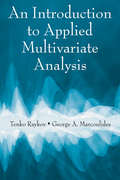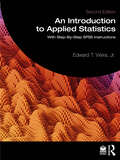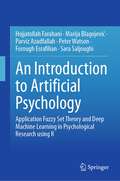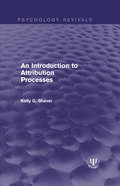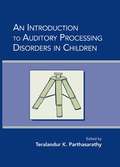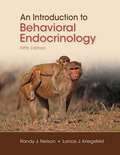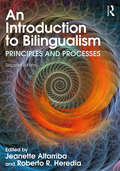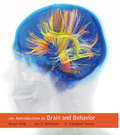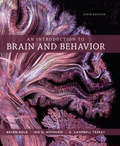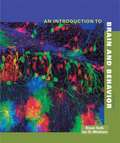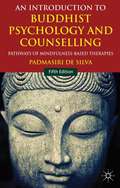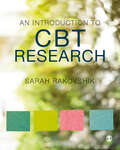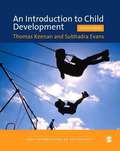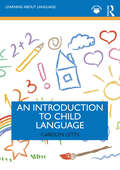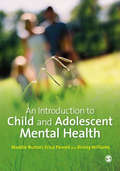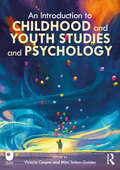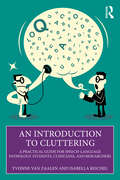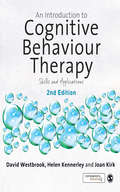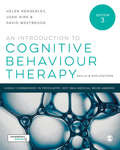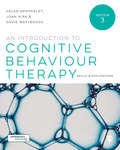- Table View
- List View
An Introduction to Applied Multivariate Analysis
by George A. Marcoulides Tenko RaykovThis comprehensive text introduces readers to the most commonly used multivariate techniques at an introductory, non-technical level. By focusing on the fundamentals, readers are better prepared for more advanced applied pursuits, particularly on topics that are most critical to the behavioral, social, and educational sciences. Analogies betwe
An Introduction to Applied Statistics: With Step-By-Step SPSS Instructions
by Edward T. Vieira, Jr.An Introduction to Applied Statistics offers a comprehensive and accessible foundation in applied statistics, empowering students with the essential concepts and practical skills necessary for data-driven decision-making in today's world. Thoroughly covering key topics – including data management, probability fundamentals, data screening, descriptive statistics, and a broad spectrum of inferential analysis techniques – this indispensable guide demystifies statistical concepts and equips students to confidently apply statistical analysis in real-world contexts.With a systematic, beginner-friendly approach, the author assumes no prior knowledge, making complex statistical foundations accessible to students from a variety of disciplines. Concise, digestible chapters build statistical competencies within a practical, evidence-based framework, minimizing technical jargon to facilitate comprehension. Now in its latest edition, the book is fully updated with SPSS v29.0 instructions and screenshots, ensuring compatibility with the most recent software developments. It also includes expanded content on addressing nonrandom sampling issues, such as case weighting, and delves into advanced topics like factor analysis, logistic regression, cluster analysis, and discriminant analysis, catering to the evolving needs of students and professionals alike.An invaluable resource for introductory quantitative research methods courses in psychology, social sciences, business, and marketing, this text combines practical examples, online resources, and an approachable format to support both learning and application.Key Features: Concise chapters integrating real-world applications: Seamlessly blends statistical skills with practical scenarios, illustrating the flexible use of statistics in evidence-based decision-making. Accessible presentation: Offers practical explanations of statistical procedures with minimal technical jargon, enhancing understanding and retention. Foundational preparation: Early chapters are designed to equip students for advanced statistical procedures, building a strong foundational knowledge. Step-by-step SPSS instructions: Provides detailed SPSS v29.0 guidance with screenshots to reinforce comprehension and hands-on skills. Real-world exercises with answers: Includes practical exercises complete with solutions to facilitate active learning and application. Comprehensive instructor resources: Offers extensive teaching support with chapter PowerPoints and test banks to enhance the educational experience.
An Introduction to Art Therapy Research
by Lynn KapitanAn Introduction to Art Therapy Research is a pragmatic text that introduces readers to the basics of research design in quantitative and qualitative methodology written in the language of art therapy, with particular attention to the fields unique aspects, current thinking, and exemplars from published art therapy research studies. This combination of a broad, standard approach to research design plus art therapies particular perspective and major contributions to the subject make the text suitable for courses in introductory research, survey of art therapy history and literature, art therapy assessment, and ethics. The book includes strategies for evaluating research reports and writing for peer-reviewed publication, features that make the text of special value to students, practitioners, doctoral candidates, and academics writing for publication. An online instructor's manual with student resources is available and offers material to enhance the pedagogical features of the text.
An Introduction to Artificial Psychology: Application Fuzzy Set Theory and Deep Machine Learning in Psychological Research using R
by Peter Watson Sara Saljoughi Hojjatollah Farahani Marija Blagojević Parviz Azadfallah Forough EsrafilianArtificial Psychology (AP) is a highly multidisciplinary field of study in psychology. AP tries to solve problems which occur when psychologists do research and need a robust analysis method. Conventional statistical approaches have deep rooted limitations. These approaches are excellent on paper but often fail to model the real world. Mind researchers have been trying to overcome this by simplifying the models being studied. This stance has not received much practical attention recently. Promoting and improving artificial intelligence helps mind researchers to find a holistic model of mental models. This development achieves this goal by using multiple perspectives and multiple data sets together with interactive, and realistic models. In this book, the methodology of approximate inference in psychological research from a theoretical and practical perspective has been considered. Quantitative variable-oriented methodology and qualitative case-oriented methods are both used to explain the set-oriented methodology and this book combines the precision of quantitative methods with information from qualitative methods. This is a book that many researchers can use to expand and deepen their psychological research and is a book which can be useful to postgraduate students. The reader does not need an in-depth knowledge of mathematics or statistics because statistical and mathematical intuitions are key here and they will be learned through practice. What is important is to understand and use the new application of the methods for finding new, dynamic and realistic interpretations. This book incorporates theoretical fuzzy inference and deep machine learning algorithms in practice. This is the kind of book that we wished we had had when we were students. This book covers at least some of the most important issues in mind research including uncertainty, fuzziness, continuity, complexity and high dimensionality which are inherent to mind data. These are elements of artificial psychology. This book implements models using R software.
An Introduction to Attribution Processes (Psychology Revivals)
by Kelly G. ShaverWhy do people act the way they do? How do their desires and fears become known to us? When are our opinions of others correct, and when are they likely to be mistaken? These are questions which attribution theory tries to answer. Originally published in 1975, this title provides an informal introduction to the field of attribution, with the theoretical principles and issues illustrated in everyday examples. The origins of current attribution theory are outlined, and models of the inference process are examined. The intellectual debt owed to social psychology by the attribution theory is acknowledged, and an exploration of the interpersonal and social consequences of attribution is included.
An Introduction to Auditory Processing Disorders in Children
by Teralandur K. ParthasarathyAuditory processing in children (APD) comprises an increasingly important clinical area within the broad field of communication disorders. This new textbook presents the major advances in the assessment and management of APD. The chapter authors, highly regarded clinicians and researchers from diverse professional groups, contribute an impressive breadth of knowledge to explain and demystify APD. This text will be useful to students of speech language pathology and audiology, as well as professionals in those fields.
An Introduction to Behavioral Endocrinology, Fifth Edition
by Randy J. Nelson Lance J. KriegsfeldAn Introduction to Behavioral Endocrinology, Fifth Edition retains all of the features of the bestselling prior editions, and provides an updated, integrated presentation of the study of hormone-behavior-brain interactions.
An Introduction to Bilingualism: Principles and Processes
by Jeanette Altarriba and Roberto R. HerediaThe study of bilingualism and all of its aspects – from theory and models to social approaches and their practical applications – forms the cornerstone of the 2nd edition of this work. The chapters cover the latest advancements in the domains of psycholinguistics, neuroscience, creativity, and executive functioning. Contributions, new to this edition, offer the reader the most up-to-date research on lifespan and developmental issues. The work also provides insight into how human language is processed by all, not just by bilingual and multilingual speakers.This text is ideal for senior undergraduate and graduate courses in psycholinguistics and the psychology of language, especially those with an emphasis on bilingualism or second language learning.
An Introduction to Brain and Behavior
by Bryan Kolb Ian Q. Whishaw G. Campbell TeskeyFrom authors Bryan Kolb and Ian Whishaw, and new coauthor G. Campbell Teskey, An Introduction to Brain and Behavior offers a unique inquiry-based introduction to behavioral neuroscience, with each chapter focusing on a central question (i. e. , "How Does the Nervous System Function?"). It also incorporates a distinctive clinical perspective, with examples showing students what happens when common neuronal processes malfunction. Now this acclaimed book returns in a thoroughly up-to-date new edition. Founders of a prestigious neuroscience institute at the University of Lethbridge in Alberta, Canada, Kolb and Whishaw are renowned as both active scientists and teachers. G. Campbell Teskey of the University of Calgary, also brings to the book a wealth of experience as a researcher and educator. Together, they are the ideal author team for guiding students from a basic understanding the biology of behavior to the very frontiers of some of the most exciting and impactful research being conducted today. The new edition also has its own dedicated version of Worth Publishers' breakthrough online course space, LaunchPad, giving it the most robust media component of any textbook for the course.
An Introduction to Brain and Behavior
by Kolb Whishaw TeskeyFrom authors Bryan Kolb and Ian Whishaw, and new coauthor G. Campbell Teskey, An Introduction to Brain and Behavior offers a unique inquiry-based introduction to behavioral neuroscience, with each chapter focusing on a central question (i.e., "How Does the Nervous System Function?"). It also incorporates a distinctive clinical perspective, with examples showing students what happens when common neuronal processes malfunction. Now this acclaimed book returns in a thoroughly up-to-date new edition. <P><P> Founders of a prestigious neuroscience institute at the University of Lethbridge in Alberta, Canada, Kolb and Whishaw are renowned as both active scientists and teachers. G. Campbell Teskey of the University of Calgary, also brings to the book a wealth of experience as a researcher and educator. Together, they are the ideal author team for guiding students from a basic understanding the biology of behavior to the very frontiers of some of the most exciting and impactful research being conducted today. <P><P><i>Advisory: Bookshare has learned that this book offers only partial accessibility. We have kept it in the collection because it is useful for some of our members. Benetech is actively working on projects to improve accessibility issues such as these.</i>
An Introduction to Brain and Behavior,Third Edition
by Bryan Kolb Ian Q. WhishawThe distinctive approach to contemporary brain science engages students by answering the basic questions about the interplay between brain and behavior --answers that incorporate the latest clinical and technological developments in research with fascinating case studies.
An Introduction to Buddhist Psychology and Counselling
by Padmasiri De SilvaThis book, now in its fifth edition, provides a comprehensive introduction to Buddhist psychology and counselling, exploring key concepts in psychology and practical applications in mindfulness-based counselling techniques using Buddhist philosophy of mind, psychology, ethics and contemplative methods.
An Introduction to CBT Research
by Sarah RakovshikThis highly practical book will guide students through the different levels of research within CBT by addressing the general principles of grappling with evidence and understanding statistics. It also highlights how to critically engage with, interpret and evaluate research so that it can be used to shape practice. This important book will help readers see the relevance of research in their working lives and empower them to become active and keen researchers.
An Introduction to CBT Research
by Sarah RakovshikThis highly practical book will guide students through the different levels of research within CBT by addressing the general principles of grappling with evidence and understanding statistics. It also highlights how to critically engage with, interpret and evaluate research so that it can be used to shape practice. This important book will help readers see the relevance of research in their working lives and empower them to become active and keen researchers.
An Introduction to Child Development
by Thomas Keenan Subhadra EvansThe Second Edition of An Introduction to Child Development has been fully updated to provide a comprehensive survey of the main areas of child development, from infancy through to adolescence. Equipping students with an appreciation of critical issues in the field and an understanding of empirical research that bears on the study of children, the text provides balanced coverage of topics and theoretical perspectives that represent both classic and cutting edge work in child development. In terms of new content, it now covers more on the biological foundations of development, plus new chapters on moral development and applied developmental psychology. The Second Edition includes the following features: - learning points - section & chapter summaries, - end-of-chapter glossaries - suggestions for further reading - sample multiple choice questions - sidebars featuring in depth discussions of key research findings or points of debate within the field of child development. The text comes with a dedicated website with resources for both students and instructors.
An Introduction to Child Development (SAGE Foundations of Psychology series)
by Thomas Keenan Subhadra Evans Dr Kevin CrowleyAn Introduction to Child Development, Third Edition provides undergraduate students in psychology and other disciplines with a comprehensive survey of the main areas of child development, from infancy through to adolescence, in a readily accessible format. It equips students with an appreciation of the critical issues, while providing balanced coverage of topics that represent both classic and cutting edge work in this vast and fascinating field. The new edition has been fully updated and features: Topical research examples from current literature in psychology, education, nursing and medicine including new material on fetal learning and the role of play New and expanded sections covering key contemporary issues in cognitive, emotional and social development New features such as 'Points for Reflection' boxes, designed to encourage the reader to reflect more deeply on the subject matter Access to an enhanced SAGE Edge companion website which features online readings, Powerpoint Slides, 'Test Yourself' questions and much more (https://edge.sagepub.com/keenan3e). This textbook is essential reading for undergraduate students taking an introductory course in child development or developmental psychology and provides a clear and accessible foundation for essays, assignments and other projects.
An Introduction to Child Development (SAGE Foundations of Psychology series)
by Thomas Keenan Subhadra Evans Dr Kevin CrowleyAn Introduction to Child Development, Third Edition provides undergraduate students in psychology and other disciplines with a comprehensive survey of the main areas of child development, from infancy through to adolescence, in a readily accessible format. It equips students with an appreciation of the critical issues, while providing balanced coverage of topics that represent both classic and cutting edge work in this vast and fascinating field. The new edition has been fully updated and features: Topical research examples from current literature in psychology, education, nursing and medicine including new material on fetal learning and the role of play New and expanded sections covering key contemporary issues in cognitive, emotional and social development New features such as 'Points for Reflection' boxes, designed to encourage the reader to reflect more deeply on the subject matter Access to an enhanced SAGE Edge companion website which features online readings, Powerpoint Slides, ‘Test Yourself’ questions and much more (https://edge.sagepub.com/keenan3e). This textbook is essential reading for undergraduate students taking an introductory course in child development or developmental psychology and provides a clear and accessible foundation for essays, assignments and other projects.
An Introduction to Child Language (Learning about Language)
by Carolyn LettsThis accessible and inclusive new textbook introduces Child Language Acquisition (CLA), with unique coverage of bilingual and early second language development as well as first languages. The majority of children worldwide will grow up to be bi- or multilingual, and early second language acquisition is a very common experience for migrant children and those in more well-established ethnic minority communities across the world. The book explores the major stages of child language development below the age of five years, covering social context, early words, combining words, inflections and function words, complexity, and use of language, but also some of the major developments that take place post five years.Including recent developments in the area, this introduction:• Emphasises the interactive development of the component skills involved in language and the wider skills on which language depends• Incorporates bilingual language development throughout, covering both two first languages and early naturalistic second language acquisition• Takes a crosslinguistic and cross-cultural approach, considering the role of input and child directed speech in the light of recent debate about links between socio-economic status and CLA and supposed ‘deficient’ language-learning environments for some groups of childrenSupported with examples taken from child language data and experimental studies, as well as exercises and activities, this student-friendly text is an essential course textbook for any module on child language acquisition.
An Introduction to Child and Adolescent Mental Health
by Erica Pavord Briony Williams Maddie BurtonAnyone who works within children and adolescent mental health services will tell you what a challenging and complex world it is. To help prepare you, the authors have produced a clear introduction to child and adolescent mental health that takes you step-by-step on a journey through the subject. Beginning with the foundations, the book explores the common mental health concepts and influences that you can expect to encounter examining topics like the difference between emotional and mental health issues and how mental health problems develop. It then moves on to explore the vital skills that you will need to develop like effective communication and basic counselling skills, and introduces some of the common interventions like Cognitive Behavioural Therapy, Psychodynamic theory and Family work. Written by a multi-disciplinary team of passionate and experienced experts, the book strikes an effective balance between introducing the relevant theory and showing how this can be applied in the real world. It is an essential starting point to the subject of child and adolescent mental health and suitable for any students planning to support this group.
An Introduction to Childhood and Youth Studies and Psychology
by Victoria Cooper Mimi Tatlow-GoldenThis exciting new book provides a novel interdisciplinary introduction to Childhood and Youth Studies and Psychology. Its accessible approach illuminates holistic understandings of children and young people’s lives by drawing from multiple disciplines and theoretical frameworks and wide-ranging research examples, including case studies from around the world, featuring children and young people’s perspectives throughout. Weaving insights from education and cultural studies, social anthropology, and sociology with social, cultural, and developmental psychology, it covers children and young people’s experiences and development from infancy to young adulthood (0–23 years) and their rights. Chapters explore key contemporary topics such as the following: - Digital childhood and youth - Children’s embodied experiences - The social and cultural origins of selves - Diverse families - Race and ethnicity - Global childhoods - Models for understanding health and disability - Children’s rights and agency - Gender in childhood and youth An essential reading for students on childhood and youth, psychology, and education courses, An Introduction to Childhood and Youth Studies and Psychology is also a valuable introductory resource for practitioners working with children and young people and for parents and policy makers with an interest in how we understand children and young people’s lives today.
An Introduction to Cluttering: A Practical Guide for Speech-Language Pathology Students, Clinicians, and Researchers
by Yvonne van Zaalen Isabella ReichelAn Introduction to Cluttering explores the speech disorder of cluttering, offering concrete, evidence-based methods for its diagnosis and treatment.Cluttering is a globally recognized communication disorder, yet it is often poorly understood. This book presents a historical overview of the efforts of pioneers in the field to demystify the cluttering disorder, before introducing the aetiology and symptoms of cluttering from several perspectives: physiological, psycho-linguistic, neurological, social, affective, and cognitive. It also provides an in-depth discussion of the identification, differential diagnosis, and assessment of cluttering, using current and advanced diagnostic procedures before explaining the rationales and unique, innovative procedures for evidence-based treatments of cluttering. Engaging practical examples and theory boxes are featured throughout the book.Providing effective and user-friendly procedures for cluttering diagnosis and intervention, this book is an essential read for all current and future speech and language therapists.
An Introduction to Coaching
by Graham Dexter Judy Irving Dr Janice DexterThis is an excellent, no-nonsense introduction to the field of coaching for developing practitioners. Using a rich array of examples from both life and business coaching, the book covers: o foundations of coaching o coaching processes o the range of coaching models, skills, attitudes and methods o the psychological underpinnings to the main theoretical approaches to coaching, e.g. cognitive, TA, NLP o different applications of coaching e.g in life-, executive- , or career-coaching o key professional issues such as ethics, evidence-based practice and contracts. o how to present and market your coaching identity and skills. Blending theory and practice, with examples and exercises, the book is aimed at professionals from a range of backgrounds, whether therapeutic, educational or business in orientation, who want to expand and transfer their skills to the coaching profession. It is essential reading on all coaching & mentoring courses.
An Introduction to Cognitive Behaviour Therapy
by David Westbrook Helen Kennerley Joan Kirk`There is much to commend this comprehensive work: it is engaging to read, accessible in style and honestly conveyed. I will certainly be including it as a key text for our university's new CBT module next year. I am reminded once again that contemporary CBT is a therapy for the people; accessible, affordable, resourceful and client empowering' - Therapy Today `[This book] is written in a very readable plain English format that gives the reader an immediate grasp of the concepts… [and] a great insight into the CBT model in a very structured and practical way. I would highly recommend this book to anyone who is curious about CBT' - Eisteach, Irish Association for Counselling and 'This book has been published at the optimum time when references to CBT are ubiquitous, and understanding the principles of this widely publicised intervention is essential. A fine balance of the evidence base, therapeutic interventions and the practicalities of the key components of intervention promotes this text to a higher level of sophistication' - Behavioural and Cognitive Psychotherapy `a worthwhile introduction to CBT and… a thorough overview of the approach that is well supported by research evidence. Written by experience practitioners in an accessible language, this book is recommended for those new to CBT. It is also a useful refresher for the more experienced therapist' - Nursing Standard, 4 star review An Introduction to Cognitive Behaviour Therapy is a beginner's guide to the basic theory, skills, and applications of CBT. Well supported by research evidence, CBT has become one of the most widely practised and most popular therapeutic approaches. For those new to the approach this practical text sets out the core concepts and generic skills of CBT including: " the method of Socratic dialogue " case formulation " the therapeutic relationship " therapeutic strategies - cognitive, behavioural, and physiological. The text then goes on to illustrate how these techniques can be applied to the most common mental health problems - depression, panic and agoraphobia, OCD and health anxiety, social anxiety, and generalized anxiety disorder. Other, less common, disorders are also explored, as are different methods of delivery including work with individuals, groups, couples, and families. This text will be invaluable to all those coming to CBT for the first time whether on training courses or as part of their everyday work. It will also be a useful refresher for those with some experience who want to remind themselves of core skills David Westbrook is Director of the Oxford Cognitive Therapy Centre (OCTC) and a consultant clinical psychologist with Oxfordshire & Buckinghamshire Mental Health Partnership NHS Trust (OBMH). Helen Kennerley is a consultant clinical psychologist with OCTC and OBMH. Joan Kirk was the founding Director of OCTC and is now a consultant clinical psychologist with OCTC and in private practice.
An Introduction to Cognitive Behaviour Therapy: Skills and Applications
by David Westbrook Helen Kennerley Joan KirkThis bestselling guide to the basic theory, skills and applications of cognitive behaviour therapy is fully updated to reflect recent developments in CBT theory. It includes in-depth material on working with diversity, and new case studies and exercises to help you reflect and explore how theory can be used to develop effective practice. The Companion Website features over 40 videos illustrating the CBT skills and strategies discussed in the book, including: · Measuring CBT's effectiveness · Socratic method and applications · Physical techniques and behavioural experiments · Applications of CBT to specific client disorders · Using supervision in CBT.
An Introduction to Cognitive Behaviour Therapy: Skills and Applications
by Helen Kennerley Joan Kirk Mr David WestbrookThis bestselling guide to the basic theory, skills and applications of cognitive behaviour therapy is fully updated to reflect recent developments in CBT theory. It includes in-depth material on working with diversity, and new case studies and exercises to help you reflect and explore how theory can be used to develop effective practice. The Companion Website features over 40 videos illustrating the CBT skills and strategies discussed in the book, including: Measuring CBT’s effectiveness Socratic method and applications Physical techniques and behavioural experiments Applications of CBT to specific client disorders Using supervision in CBT.
